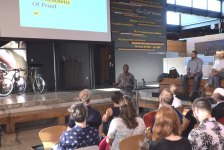5 Examples of Better Bike Infrastructure
by April Streeter, Gothenburg, Sweden on 01.19.09
http://www.treehugger.com/files/2009/01/5-improvements-to-bike-infrastructure.php?daylife=1&dcitc=daylife-article
Bike transport innovations just never get the same mainstream media coverage – or popularity, even on TreeHugger – that car news enjoys. Yet so much is happening as bike sharing booms in cities and on college campuses across the world, ridership increases, and the bike industry is one of the few that is seemingly insensitive to economic mayhem! In the bike universe, small changes in infrastructure are making a big difference (mostly better) in bike commuters’ lives. So here we give you a few of the ideas becoming more popular in improving bike transport, safety, and the biking way of life. Viva velo!
1. Wrong way driving in Stockholm
Stockholm’s municipality is trying something novel: letting cyclists on chosen streets (mostly in semi-suburban neighborhoods) ride against traffic on one-way streets. The practice, also being piloted in London, is meant to give cyclists a method to keep moving on less-busy streets and when bike paths are unavailable.
2. City street with the same speed limit for all vehicles
This is also an idea Swedes are mulling, put forth by the Social Democrats (not the ruling party but part of the coalition government). As dedicated cyclist Anneli Hulthéns describes in for The Gothenburg Post, “another possibility is to blend pedestrians, cyclists, and cars but then one wouldn’t be able to drive faster than people can walk, the same way we do on some streets inside the old inner city.” While it is being considered for future improvements, as Hulthéns notes it already works on streets such as Magasingatan pictured above. The country’s Parking administration also has been instructed to “work with long-term solutions for future bike parking and commuter parking.” Hooray.
3. Bike street parking á la Portland’s corrals
Portland is embracing the concept of bike corrals – in which two car spaces are converted into 24 bike spaces. One of the first, on dense Belmont Avenue in Southeast Portland, was a success not only for cyclists and pedestrians fed up with bike clogging the sidewalk, but also for merchants. The first bike corrals, on Belmont and one in the city’s Mississippi district, had yellow rubber bumpers and curbs outlining the spots. The new corrals are just pavement line markers, reflectors, and bike racks, according to Bike Portland. Based on feedback, the designs will be modified this spring. Corrals cost the city or merchants around $3-$4,000.
4. Green Broadway Boulevard in New York
New York has done so much for biking in the last few years. In addition to the 2006 mandate that has led to New York laying down 200 miles of bike paths there is: Madison Square’s transformation; Seven blocks of Broadway with green-painted bike lanes and pedestrian improvements plus lots of hang-out space; and the ‘complete streets’ where the parking lane and the bike lanes are switched and a median buffer is put between cyclists and other vehicular traffic (perhaps we should dub these Copenhagen-style lanes?). A Streetfilms video nicely spells out these changes and more.
5. Sharrows crop up everywhere
The separate-lanes concept of biking versus the sharrows concept (arrows on the vehicle roads signaling vehicle drivers that bikes might be there to share) will probably be one of those “paper versus plastic” debates that are never really put to rest. Bikers like myself will tend to prefer separate lanes for the perhaps-foolish feeling of safety. Sharrows seem like a tool for those bikes that live in the fast lane – messengers, racer types. However, it seems to be part of an evolution – first there need to be bike lanes to get people out there, then sharrows can move the faster bikers to sharing the road. And maybe the rest of us will follow!










